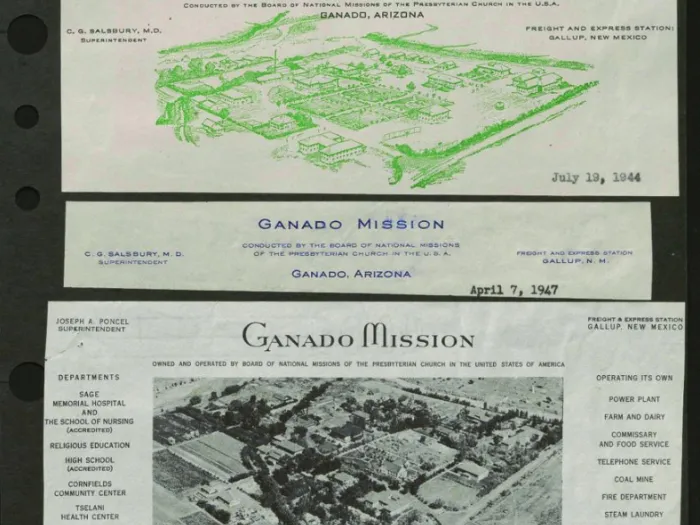Scattered throughout the PHS building on 425 Lombard Street are several museum items on display. If you've visited us, perhaps you've seen a few of them—like Cornelia, our small reed pump organ that sits on the first floor, welcoming researchers into our Reading Room.
But for those of you who are scattered across the country—across the globe, even—there may not be a chance to wander our halls or our Philadelphia city block. And so, we present: The Curio Cabinet. Here, you’ll find images and descriptions of some of the objects preserved and presented throughout our building.
This is Volume 2 of a two-part-blog-series. You can read Volume 1 here.
***
ITEM THREE—TOMBSTONE—JOHN BOYD
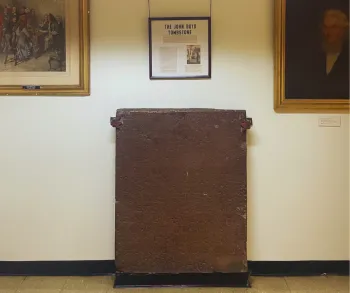
Catty-corner to the door that leads into the archives annex there is a large slab of rock. This is not just any stone: this is the John Boyd tombstone.
Boyd was born and spent his childhood in Kilmarnock, Scotland, where he lived until he attended the University of Glasgow. It is believed that after graduating Boyd left his home country, alongside leading Presbyterian ministers Francis Makemie and John Hampton, in the fall of 1705.

On December 29, 1706, congregants gathered for the first recorded meeting of a presbytery in the colonies. At this inaugural meeting, John Boyd, a Scotsman living in the colonies, was ordained. This is the first recorded ordination of a Presbyterian minister in America.
During his brief ministry, the Rev. Boyd primarily served the Old Scots Church in Freehold, New Jersey. Sadly, less than two years after his ordination, John Boyd passed away—on August 30, 1708—and was buried in the cemetery of his church.
Where’s Boyd’s congregation today?
Though the location of this December 1706 meeting is lost to history—along with the missing first page of minutes—Boyd’s association with the Old Scots Church of Freehold suggests the possibility that the gathering occurred on that congregation’s property. Their first sanctuary was built on the site of what is now called Old Scots Burying Ground, in Marlboro Township (where Rev. Boyd was buried).
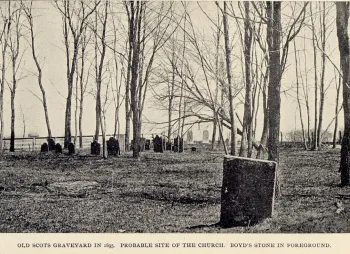
In 1730, a second sanctuary was built, about five miles away from the original house of worship. The congregation had been growing at a steady pace, and many new immigrants had arrived in the area looking for resettlement. Two decades later, a third building was constructed—on the same site as the second church—that is still used for worship today, by members of Old Tennant Church.
This congregation, though initially known as Old Scots Church, was referred to by a variety of names throughout the decades that the congregation met. It went from Old Scots Church to Freehold Church, and then, in later years, the Old Tennent Church, in memory of the Rev. John Tennent and his brother, the Rev. William Tennent.
See “Old Scots Church and Presbyterian Beginnings in New Jersey” for further reading
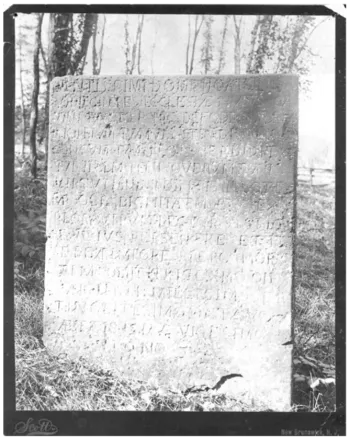
John Boyd Tombstone in Old Scots Cemetery, Freehold, NJ. 1908.
Boyd’s Travels to Philadelphia
The original tombstone, though it is displayed vertically, was originally a table stone—about five feet in length and meant to be laid horizontally on a bed of stone and lime. The inscription, written in Latin, reads:
"The ashes of the very pious Rev. John Boyd Pastor of this church of Calvin, are here buried, whose labour, although expended on a sterile soil, was not lost. They who knew him well also proved his worth who was at that time distinguished for his virtues. Reader, follow perseveringly his footsteps, and I hope thou wilt be happy. He died on the thirtieth day of August, one thousand, seven hundred and eight, in the twenty-ninth year of his age."
[Henry Goodwin Smith, The History of the "Old Scots "Church of Freehold. Transcript Printing House, Freehold, NJ, 1895, Page 28]
At the turn of the 20th century, Boyd’s tombstone was replaced by a Presbyterian Historical Monument. This was done in part to protect the oversized stone from deterioration, as a safety precaution of sorts.
In the January 1, 1901 edition of the Robesonian, the journey of the tombstone was mentioned to readers in the following language:
Historic Tombstone Removed: Freehold, N.J., December 29. A tombstone which marked the grave of the first pastor of Old Scot's Church, ordained 194 years ago today, has been removed from Old Scot's Cemetery, near this city and taken to Philadelphia, where it has been placed in the rooms of the Presbyterian Historical Society. It is of rough-hewn brownstone, about three feet high, two feet broad, and two inches thick. It marked the grave of Rev. John Boyd, Last spring a monument was unveiled over his grave, so the old tombstone become useless.
When it was removed, it was gifted to us—the Presbyterian Historical Society—and the Synod of New Jersey erected a monument to Rev. Boyd to replace where the headstone once lay.
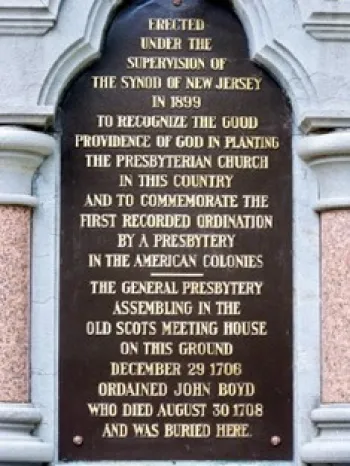
Photo courtesy of Log College Press.
***
ITEM FOUR—MODEL SHIP—STEAMER
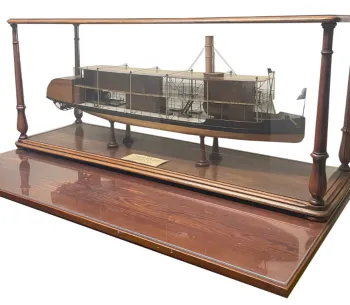
In 1898, Lachlan Cumming Vass II—the son of Lachlan Cumming Vass, a Presbyterian minister and chaplain in the Confederate Army—volunteered to serve as a missionary to the Congo Free State, working under the auspices of the Presbyterian Church in the United States' Executive Committee of Foreign Missions. There, he and his fellow Presbyterian missionaries raised their voices in protest against the oppressive and violent regime of King Leopold II over the people of the Congo, working hard to publicize the atrocities that were taking place.
Simultaneously, Vass II also participated in the construction and command of two steamboats that would be used to sail along the Congo River. These two crafts shared the same name: the SAMUEL N. LAPSLEY.
The Steamboats’ Namesake

Who was this man, that his memory lived on in such a strong way? Samuel N. Lapsley was none other than the co-founder of the American Presbyterian Congo Mission (APCM).
Lapsley, a white minister from Alabama, was appointed to the Congo Mission in 1890, arriving at the same time as William H. Sheppard, one of the first African American missionaries for the Presbyterian Church. The two worked together to establish the mission at Luebo, in the province of Kasai. Unfortunately, Lapsley died of a “bilious hematuric fever” just two years later, in late March of 1892—a sudden death, quite unexpected. Sheppard carried on the work that they had started together, acting on his own until additional missionaries arrived the following year.
Despite their short friendship, Lapsley must have made quite the impression on his fellow missionary—when the Sheppards welcomed their second child into the world, they bestowed upon him the name William Lapsley (though, for some reason, the child’s nickname was Maxamalinge).
Sailing and Sinking
Fast forward a few years and see the dockworkers piecing together the Samuel N. Lapsley steamer. Once completed, the boat was used to transport supplies from Leopoldville to Luebo Station, which was the center of activity for the American Mission.
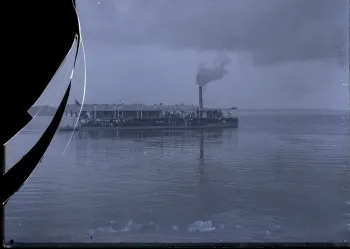
Ship, 1898. [Pearl ID: islandora:7214].
Just a few years after its creation, however, the first LAPSLEY steamer capsized. It was 1903, and 24 people drowned as the boat sank below the surface of the Congo River current. This is why there were two, after all—following the tragedy, Vass II supervised the construction of the replacement vessel, a second LAPSLEY that was pieced together on the Clyde River in Scotland two years after the sinking of its predecessor. Once finished, the boat was then dismantled, shipped to Central Africa, and rebuilt on the Congo River in 1906.
(Vass II, after resigning from the APCM, married Frances S. Sharp in 1911, with whom he had three children: John, Sophie, and Lachlan Cumming Vass III. Vass III would grow up to follow in his father’s and grandfather’s footsteps, becoming an ordained minister in 1940—the same year he wed Winifred Kellersberger, who had been born at the APCM in Lusambo and raised in the Congo! What a coincidence! After they were wed, the Vasses left for the APCM, spending thirty years together in the country. Together, the couple authored The Lapsley Saga, a story of the Congo Mission steamers built by Vass II.)
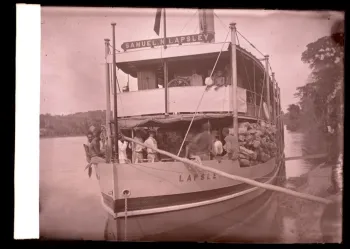
Lapsley, 1890. [Pearl ID: islandora:7440].
Our Mini Steamer
The replica that lives on our basement floor is of the second Samuel N. Lapsley steamboat, the one that was constructed in Scotland and then disassembled for shipping. We know this because of the plaque that is inscribed with the name of the shipbuilding company that built it: Lobnitz & Co., Ltd. They built all kinds of vessels, including dredgers, floating docks, fishing boats, tugboats, and workboats—and in this case, steamboats.
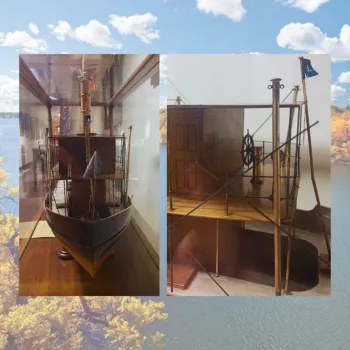
See our Guide to the Vass Family Papers to read more about their work in the Congo
See our Guide to the American Presbyterian Congo Mission Records
You may freely reuse and distribute this article in its entirety for non-commercial purposes in any medium. Please include author attribution, photography credits, and a link to the original article. This work is licensed under a Creative Commons Attribution-NonCommercial-NoDeratives 4.0 International License.




